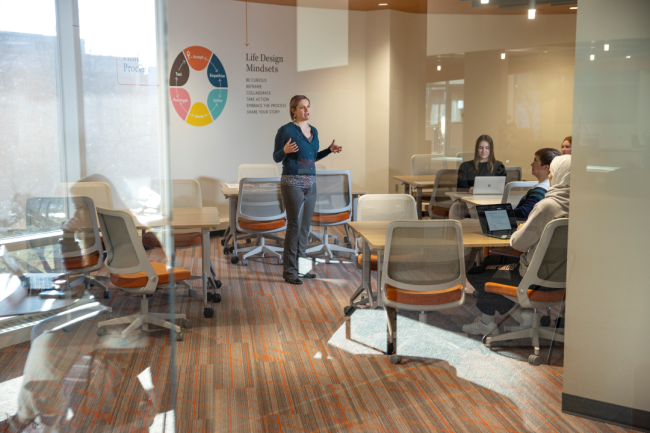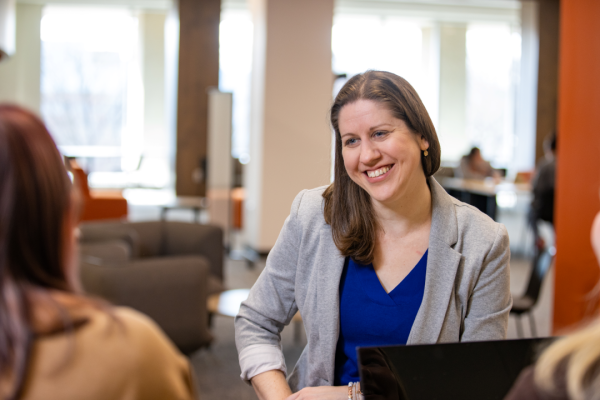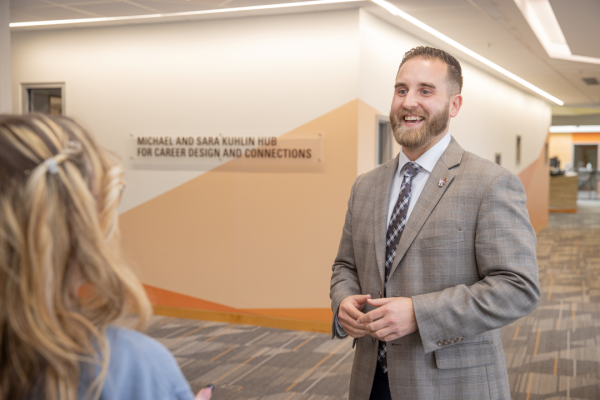You have /5 articles left.
Sign up for a free account or log in.

Life Design Coach Molly Weiland speaks to MFA, MSED. and MBA students in the Geoffrey H. Radbill Center for College and Life Design. Life Design Coaches teach courses and offer one-on-one advising support.
Craig Bell/Bowling Green State University
Many students enter college with anxiety about what their future will hold. Bowling Green State University seeks to give students the opportunity to design their life for the future by providing institutional scaffolding and support to best identify goals and career aspirations.
BGSU’s Life Design program piloted in 2020, introducing students to the concepts of design thinking and identifying mindsets to promote career-readiness and confidence in their academic pursuits.
The initiative is supported by $13.5 million in alumni gifts and reimagines student support services, as well as adds coaching staff.
The background: Life Design comes from a course by Bill Burnett and Dave Evans at Stanford called “Designing Your Life,” says Adrienne Ausdenmoore, assistant vice president and executive director of Bowling Green’s Radbill Center for College and Life Design.
“Life Design as a framework is essentially taking the concepts of design thinking—so this creative problem-solving process that includes empathy, ideation, defining the problem, trying some things, prototyping—and then where do you go from there? If you apply that concept to your life, that’s life design.”
Life Design features six mindsets—get curious, reframe, collaborate, take action, embrace the process and share your story—which encourage students to be empowered as the designer of their own college experiences.
The concept of Life Design has been a feature in higher education for at least a decade, Ausdenmoore says, but Bowling Green is embracing the initiative university-wide, something no other institution has done before.
How it works: Individual student journeys using Life Design will look different, but the idea is planning and experimenting with future plan scales throughout their time in college, culminating at graduation and starting a career or next step.
Life Design is a theme throughout recruitment and orientation, so students and parents are aware and learning about the themes prior to the first year, Ausdenmoore says.
In the first term, students are automatically enrolled in a one-credit course that helps them outline their ambitions and goals during and after their time at college. The courses are taught by BGSU’s 12 Life Design Coaches, who provide one-on-one support and resource connection to learners for all four years.
The first-year seminar also provides a community for students who may be undecided on a major program or whose majors lack a cohort experience.
During the second year, students continue with coaching and begin to explore career connections and prototype experiential learning opportunities. “As students start to explore what those career paths might look like, that’s where we really want to create that funnel directly to [the Kuhlin center],” Ausdenmoore says.

Ausdenmoore serves as the executive director of the Radbill Center.
Craig Bell/Bowling Green State University
The third year, students participate in in experiential learning, co-ops, internships or research to expand career planning. By the fourth year, students will be able to launch into their career with confidence in their vocation.
Reframing student services: As part of the university-wide initiative, BGSU opened two new centers for Life Design work focused on the overall student experience and career development. Over $13 million in donor gifts funded and named the hubs—the Geoffrey H. Radbill Center for College and Life Design and the Michael and Sara Kuhlin Hub for Career Design and Connections.
Both centers are housed in the president’s office under the purview of the vice president of student engagement and success.
The Radbill Center houses the 12 Life Design Coaches and a newly renovated space for students to meet for coaching or with peers on campus.
“A lot of what the Radbill Center does is help students get connected on campus, make some decisions about future career, major, that sort of thing,” Ausdenmoore says. The center is also action-oriented, recognizing the high cost of a college education and that students need pragmatic support to overcome roadblocks.

Russell serves as assistant vice president and executive director of the Michael and Sara Kuhlin Hub for Career Design and Connections.
Bowling Green State University
The Kuhlin Hub serves as a space for career services and programming to support on-campus work, career coaching and post-graduation preparation.
Steve Russell, assistant vice president and executive director of the Kuhlin Hub, and his team strive to be intentional in the ways they service students, whether that’s through expanding professional networks, placing them in industries that are relevant to their aspirations or in creating student employment opportunities.
“What we’re essentially hoping that they do is focus much more on receiving an offer for a job and not seeking out a job,” Russell says. Rather than searching job boards for specific titles, BGSU staff want students to identify the work they see themselves doing and partner with companies to find that kind of work.
The Kuhlin Hub also partners with the provost’s office to supply feedback from corporate and industry partners to inform academic programming and relevancy of content for career development.
Measuring impact: BGSU launched a pilot version of the Life Design program in fall 2020 for incoming students and will complete analysis of their experiences with the program as they move toward graduation in spring 2024.
The program will more formally roll out this fall with the opening of the new centers and staff, who will build out research and assessment protocols to track students throughout their time in college, Ausdenmoore says.
In the coming years, BGSU will also collect data from alumni to see how Life Design has impacted their career outcomes.
If your student success program has a unique feature or twist, we’d like to know about it. Click here to submit.




